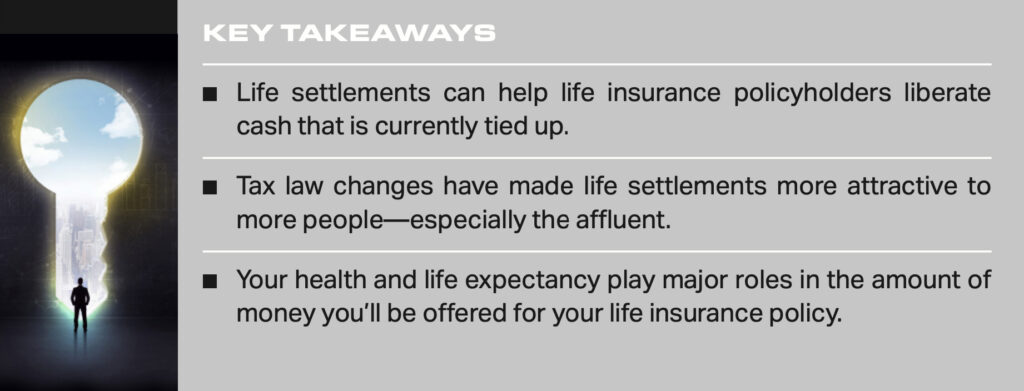Posted on: August 1st, 2018

You know that life insurance policy you’ve been paying for all these years? It could get you a nice sum of money now—while you’re still around to use it.
That’s because you may be able to sell your policy for cash through a process known as a life settlement.
Here’s how it typically works:
While not extremely well-known, life settlements are becoming more common—especially among some affluent households that have insurance policies meant to pay their estate taxes down the road. The reason: The Tax Cuts and Jobs Act of 2017 increased the estate tax exemption to approximately $11 million for individuals and approximately $22 million for couples.
That higher amount means more families may no longer need life insurance they’ve earmarked to pay the federal estate tax—so they’re selling their policies for tidy sums.
Here’s a closer look at life settlements, along with advice that can help you decide whether they may be a smart move for you.
If you have a life insurance policy you no longer need or want, you can surrender it to the insurance company and receive its cash value or you can let the policy lapse.
However, as noted above, a life settlement is almost always the superior choice economically. Chances are, you’ll get more money if you go this route.
People sell their life insurance policies for a variety of reasons. If you find yourself in one or more of these situations, it probably makes sense to at least consider a life settlement:
The caveat: Life settlements are generally for seniors usually no younger than 65. That’s because a company that buys policies doesn’t want to be stuck paying premiums for decades as it waits to collect on the death benefits. Put more simply, you’ll probably get a better offer if you’re old and in relatively poor health.
The amount of money you might be paid for your policy depends on several factors—including the policy’s face value and premiums along with your life expectancy. Getting a life settlement payment is a five-step process:

To see how life settlements can make good sense, consider these examples.
Navigating the life settlement process can be tricky. Certainly, the industry is better regulated than it used to be. Most states now require the companies that buy policies to be licensed and disclose fees and other financial information to policyholders.
That said, regulations can vary from state to state. And there’s no shortage of fine print in some of the offers that these companies make.
Our advice: Sit down with a wealth manager who has experience in this area, to determine whether the strategy in general makes sense—and whether a particular contract to buy your policy has terms and conditions that are really in your best interest.
Action step: If you think you or a family member could potentially benefit from selling an existing life insurance policy, contact your legal or financial professional to explore the topic further.
This report was prepared by, and is reprinted with permission from, VFO Inner Circle. AES Nation, LLC is the creator and publisher of VFO Inner Circle reports.
Disclosure: The opinions expressed in this commentary are those of the author and may not necessarily reflect those held by Kestra IS or Kestra AS. The material is for informational purposes only. It represents an assessment of the market environment at a specific point in time and is not intended to be a forecast of future events, or a guarantee of future results. It is not guaranteed by Kestra IS or Kestra AS for accuracy, does not purport to be complete and is not intended to be used as a primary basis for investment decisions. It should also not be construed as advice meeting the particular investment needs of any investor. Neither the information presented nor any opinion expressed constitutes a solicitation for the purchase or sale of any security. Securities offered through Kestra Investment Services, LLC (Kestra IS), member FINRA/SIPC. Investment advisory services offered through Kestra Advisory Services, LLC (Kestra AS), an affiliate of Kestra IS.
Fusion Wealth Management is not affiliated with Kestra IS or Kestra AS. https://www.kestrafinancial.com/disclosures
VFO Inner Circle Special Report
By Russ Alan Prince and John J. Bowen Jr.
© Copyright 2021 by AES Nation, LLC. All rights reserved.
No part of this publication may be reproduced or retransmitted in any form or by any means, includ- ing, but not limited to, electronic, mechanical, photocopying, recording or any information storage retrieval system, without the prior written permission of the publisher. Unauthorized copying may subject violators to criminal penalties as well as liabilities for substantial monetary damages up to $100,000 per infringement, costs and attorneys’ fees.
This publication should not be utilized as a substitute for professional advice in specific situations. If legal, medical, accounting, financial, consulting, coaching or other professional advice is required, the services of the appropriate professional should be sought. Neither the authors nor the publisher may be held liable in any way for any interpretation or use of the information in this publication.
The authors will make recommendations for solutions for you to explore that are not our own. Any recommendation is always based on the authors’ research and experience.
The information contained herein is accurate to the best of the publisher’s and authors’ knowledge; however, the publisher and authors can accept no responsibility for the accuracy or completeness of such information or for loss or damage caused by any use thereof.
Unless otherwise noted, the source for all data cited regarding financial advisors in this report is CEG Worldwide, LLC. The source for all data cited regarding business owners and other professionals is AES Nation, LLC.